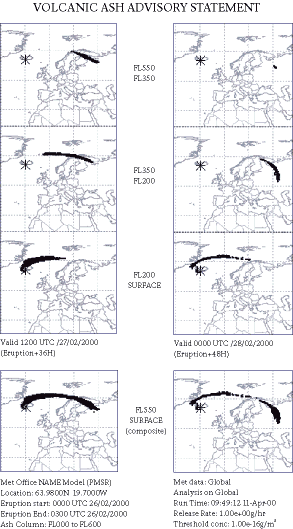
"We sent ten Boeing 747 and Airbus 340 jets on transfer flights from Munich to Frankfurt," Lufthansa spokesman Klaus Walther told the paper. The planes were moved in order to be in the most useful place once the ban is lifted, he explained.Source: "the Local"
"Our machines flew to a height of 24,000 feet, or around 8,000 metres. In Frankfurt the machines were examined by our technicians. They didn't find the slightest scratch on the cockpit windscreens, on the outer skin nor in the engines."
"The flight ban, which is completely based on computer calculations, is causing economic damage in the billions. This is why, for the future, we demand that dependable measurements must be available before a flight ban is imposed."
At left: the model from the Met Office used to look at dispersion. [Click on image for clearer rendition]
The Nuclear Accident Model (NAME) was originally developed after the nuclear accident in 1986 at Chernobyl, which highlighted the need for a capability to predict the spread and deposition of radioactive material released into the atmosphere. The model has continued to be developed and is now applied to a wide range of atmospheric pollution problems, ranging from emergency responses to daily air-quality forecasts.
Over the years, NAME has been applied to a number of atmospheric releases, including radioactive releases, the Kuwaiti oil fires, major industrial fires and chemical spills, and two major volcanic eruptions that occurred in Iceland. Both of these eruptions resulted in aircraft having to be re-routed to avoid potentially dangerous ash clouds. An example of the volcanic ash guidance provided to the aviation community is shown in Figure 1.
Source: NWP Gazette
Here is what Professor Jerom Ravetz of Oxford has to say about the issue (via email):
Interim contribution to the Post-Normal Science debate
Considering the effects of the Icelandic volcano on air transport, we seem to have:
- Facts Uncertain: how thin must the dust be, for it to be safe enough for flying?
- Values in Dispute: Regulators wanting safety at all costs, others needing to get flying now.
- Stakes High: Crippling costs to industry, versus big risks to aircraft and people.
- Decisions Urgent: Every day the immediate costs mount, and the long-term costs grow.
h/t to WUWT readers Nigel Brereton and Bernd Felsche



Reader Comments
to our Newsletter